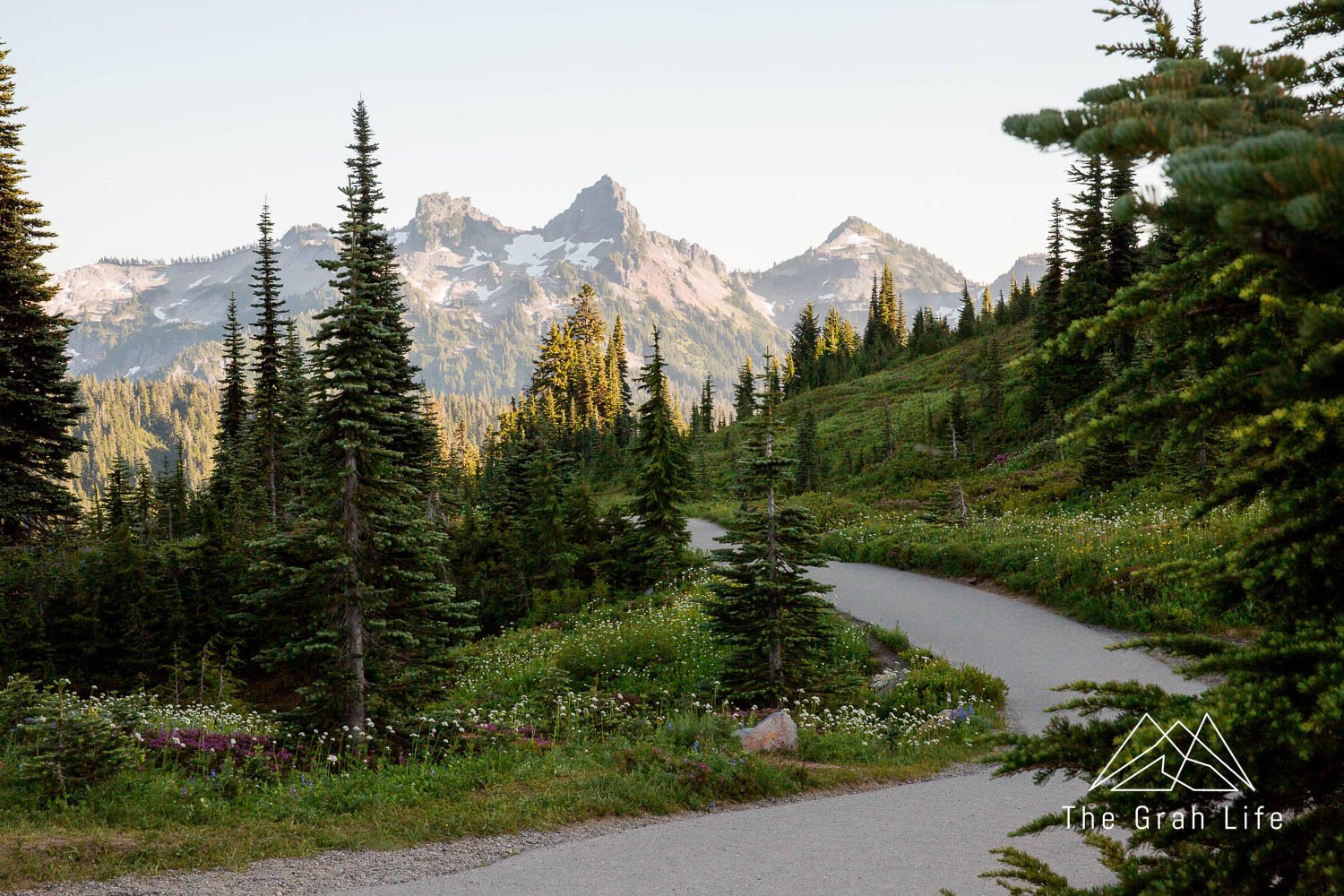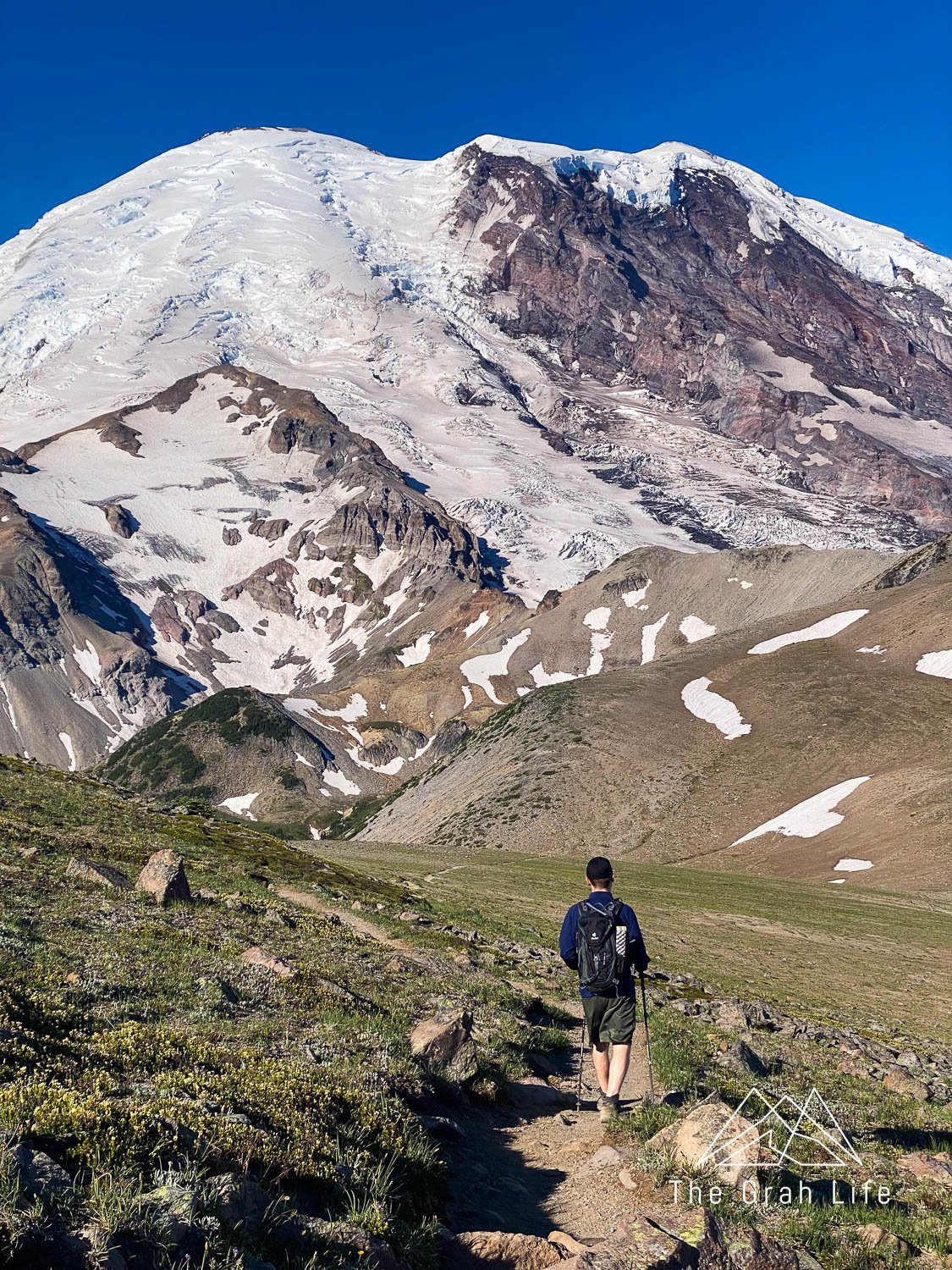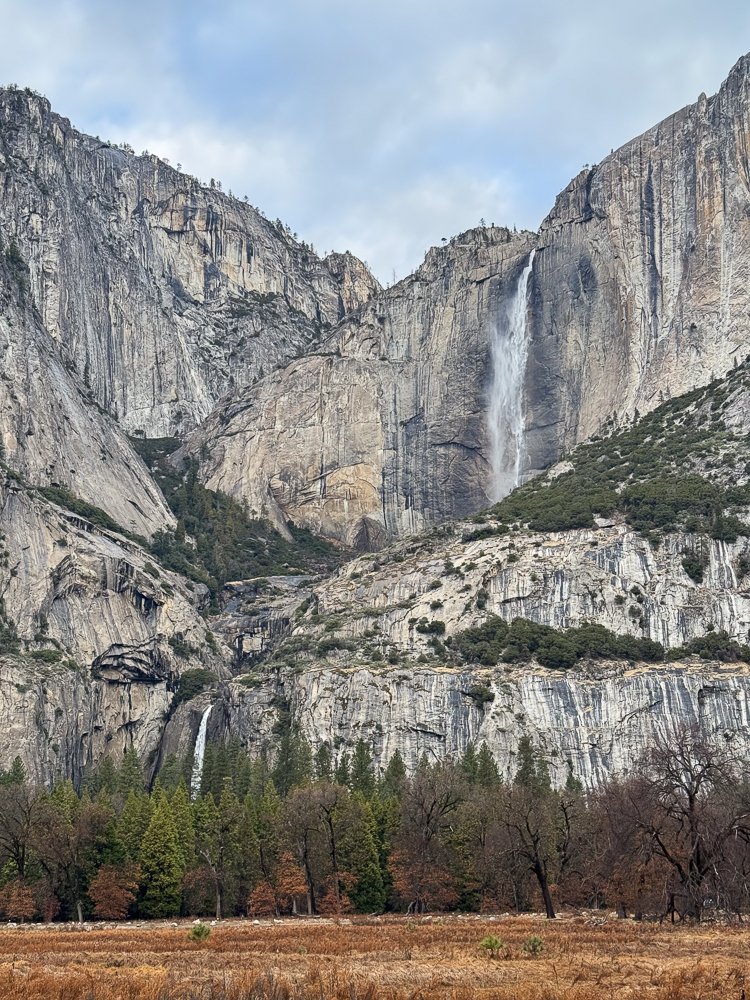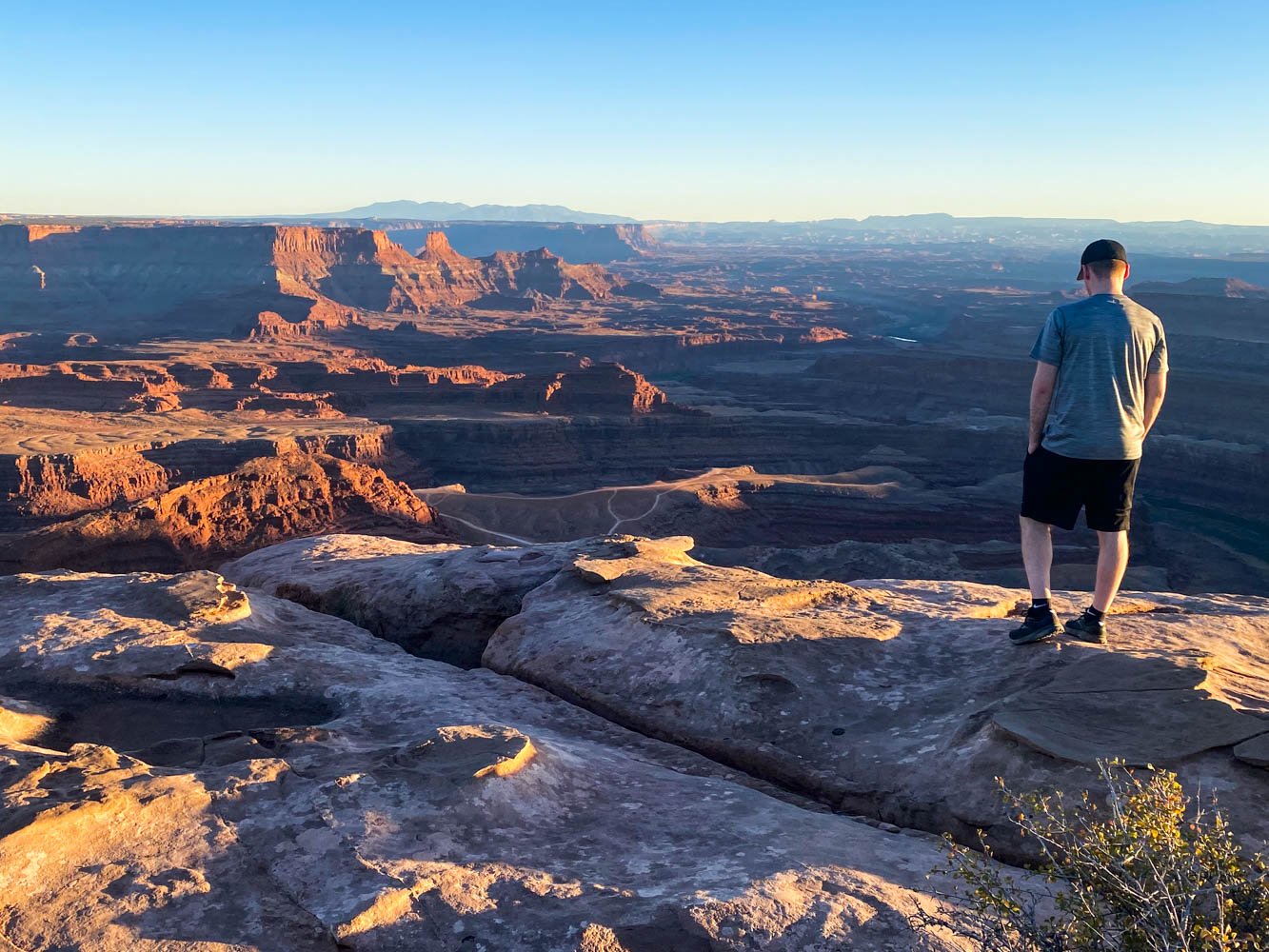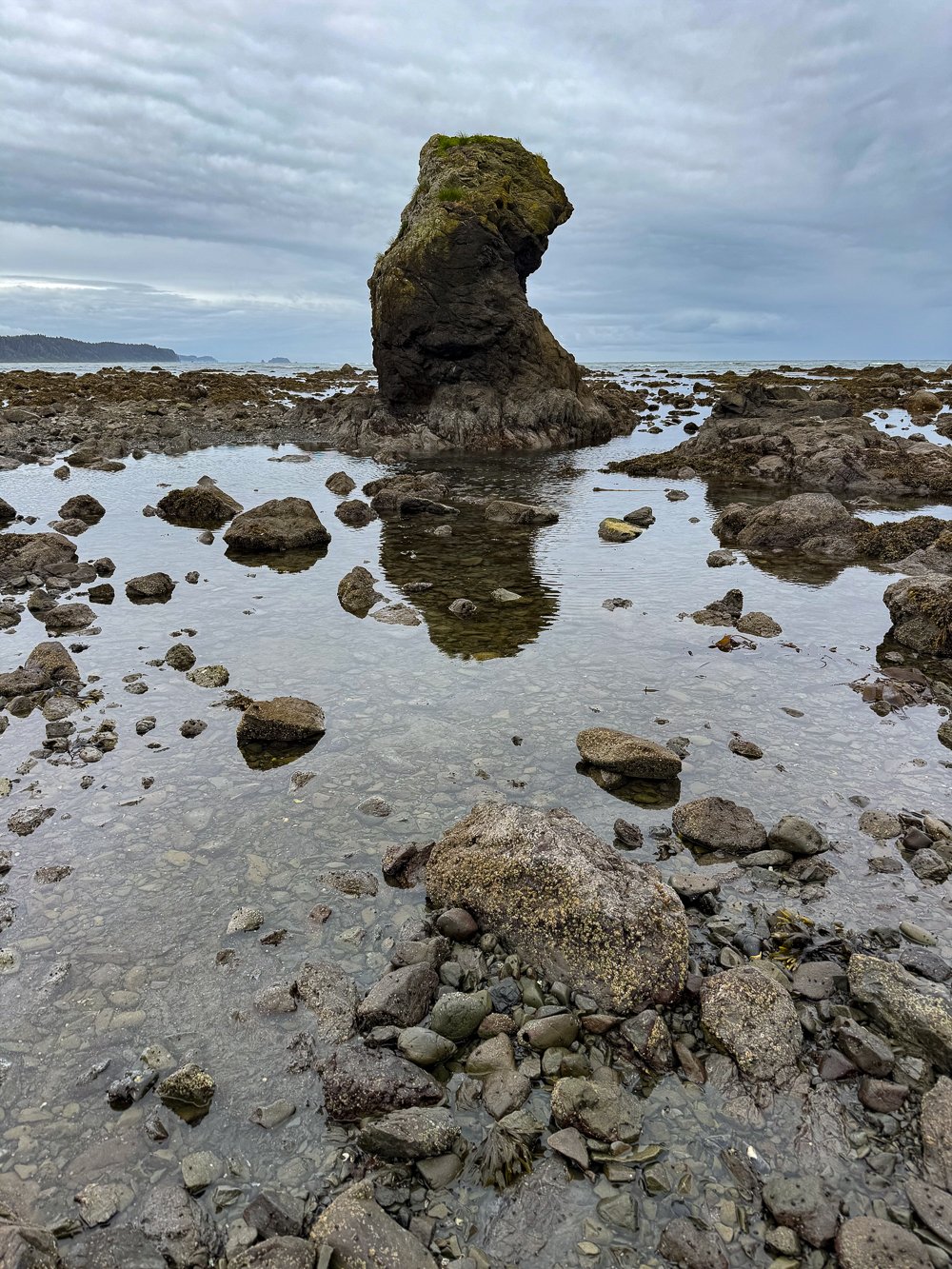Mount Rainier National Park Itinerary (From Locals)
At 14,410 feet above sea level, Mount Rainier stands far above the surrounding Cascade Mountains. It’s so distinct that locals refer to it as “the mountain” and have an unofficial motto: “Live like the mountain is out.”
We recommend spending between one and five days near the park and suggest erring on the side of more time if you enjoy hiking and scenic drives.
Click below to skip to a section:
Mount Rainier National Park entrances
Getting to Mount Rainier National Park
The Seattle-Tacoma International Airport (SEA) is the nearest major airport, located about an hour and a half away from the Nisqually entrance to the park. The Portland International Airport is also a good option, just over two hours away. No matter where you choose to fly into, exploring the park with your own car is the best way to experience Mount Rainier.
Golden Gate Trail
National park pass
To enter the park, you’ll need to have an America the Beautiful Pass or pay the entrance fee (details here). You can buy either at the gate as you enter the park, but you can get through the line faster if you already have a pass by purchasing it online.
Tolmie Peak
Timed entry reservations
Starting in 2024, Mount Rainier National Park is piloting a timed entry reservation system. We explain all the details in this blog, but in short, you’ll need to buy a timed entry permit to enter the park during regulated hours or arrive before 7:00 am.
Best time to visit
Summer
Mid-July to early October
Summer is the best season to visit Mount Rainier because all the hikes at higher elevations are safe and accessible. Since Rainier is usually covered in clouds throughout the winter, summer also gives you the greatest chance of seeing the mountain. However, Rainier is so much taller than the surrounding mountains it creates its own weather (lenticular clouds that sit atop the mountain), so there is always a chance that the mountain is hiding during your visit.
Although Washington is known for rain, summers are usually sunny and beautiful, with temperatures ranging between 60 and 70 degrees at the Paradise Visitor Center on the mountain and 70 to 80 degrees at lower elevations.
July and August are the busiest times to visit Rainier, but it’s worth braving a few crowds to see the wildflowers blooming in the alpine meadows — they usually peak around mid-August.
Crowds start to lessen in September, and by early October, there are fall colors in the meadows. Although the temperatures dip down the 50s and there are higher chances of rain, fall is still a great time to visit Mount Rainier.
Come prepared with rain jackets and a few more layers, since the weather can change quickly, and you’ll experience the park with significantly fewer tourists. By November, many trails and roads at higher elevations have closed for the year, so visit by early October to have as much of the park accessible as possible.
We’d advise avoiding visiting any earlier than July. With snow melting, hiking at Rainier in spring is dangerous, and few trails are accessible.
Mount Rainier National Park entrances
There are four entrances to Mount Rainier National Park. Some are closed to cars, scheduled for construction, or only open seasonally, so plan your trip accordingly.
Nisqually entrance
Located on the southwest side of the mountain, near Ashford, WA, this is the most popular entrance since it’s open year-round and closest to main highways. From here, you’ll have easy access to the Longmire and Paradise Visitor Centers at Mount Rainier.
Skyline Trail
Stevens Canyon
Located on the southeast side of the mountain, Stevens Canyon Road is open seasonally, usually between late May and September. The closest town is Packwood, WA.
White River
Located on the northeast side of the mountain, closest to Greenwater, WA, this is the entrance that leads to the Sunrise Visitor Center. It usually opens in July and closes in late September to early October, depending on snow levels.
Carbon River – closed indefinitely
The Carbon River/Fairfax Bridge is closed to cars and pedestrian traffic as of 2025. You can no longer drive to Mowich Lake or the trailheads for Tolmie Peak, Spray Park, and Summit Lake.
Tolmie Peak
Where to stay
The towns surrounding Mount Rainier are adorable, but small, with minimal restaurants and amenities. Lodging and campsites tend to book up quickly around the park, so plan your accommodations ahead of time.
If you have limited time, we recommend following our itinerary below and traveling from town to town to see as much as possible. Otherwise stay in Ashford, Packwood, or Greenwater for the nearest access to the park.
Viewpoint near Greenwater
Camping
Camping is a great way to experience the park, however, reserving a campsite can be competitive during the peak season. Check out this blog for Rainier’s best campsites in and around the park with tips on how to snag a booking.
Nisqually River near Cougar Rock Campground
Hiking
Mount Rainier is best known for hiking. It has over 250 miles of trails, and each hike is jaw-dropping. Choose between seeing waterfalls, wildflower meadows, close views of the mountain, alpine lakes, or a bit of each with recommendations in the itinerary below. For more hiking suggestions at Rainier, check out this list.
Always look at recent trip reports on Washington Trails Association for any of the hikes you’re interested in. They’ll give you up-to-date information on the trail, snow conditions, mosquitoes, and more.
Mildred Point
Best activities
There’s plenty to see and do around Mount Rainier aside from hiking. Since the mountain is large, plan your outings based on which town or entrance you’ll be nearest.
Ashford/Nisqually entrance
Rail Cycle at Mt. Rainier
This is a new attraction! This railroad is pedal-powered, so you’ll be biking along tracks while enjoying the views of rivers and forests. They say it’s easy to pedal and accessible for many — and we’re excited to try it out soon.
Cannibal Hot Tub
Hot tub over an open fire at Paradise Village. Fill the tub with as much cold water as you like, and you can reserve a time slot between one and three hours. It’s the perfect way to unwind after a hard hike.
Ranger-led programs
Check here to see all the ranger-led programs throughout the park. It’s updated seasonally, and we especially love the guided walks. They make sure to include everyone, go at a pace the whole group can handle, and share tons of information about the local fauna and wildlife.
Northwest Trek Wildlife Park
Located in Eatonville, a half hour from Ashford, Northwest Trek is home to 40 native Northwest animals, from bison, moose, cougars, wolves, to owls and newts! We recommend reserving a Keeper Adventure Tour or the Wild Drive Tour to spot animals in the 435 acres of free-roaming area.
Greenwater/White River entrance
Crystal Mountain
Crystal Mountain is a great spot to visit year round. They have great ski trails in the winter, and in the summer you can enjoy a scenic gondola ride, a meal at the Summit House, or check out their adventure park!
Mount Rainier 1-4 day itineraries
These itineraries are listed in order of what we recommend doing and seeing first, so each day can be stacked with the previous day to create an itinerary for your length of stay.
Itinerary breakdown
Day 1: Ashford to Packwood
Day 2: Sunrise Visitor Center
Day 3: Extend your stay in Ashford
Day 4: Extend your stay in Greenwater
Day 5: Carbon River
Day 1: Ashford to Packwood
Mileage: 60
Drive time: 2 hours
Start: Ashford
End: Packwood
We recommend starting your day in Ashford. From there, you’ll spend your day driving to the Paradise Visitor Center, stopping at all the sights and viewpoints along the way. End your day in Packwood.
We recommend stopping at the following:
Christine Falls
Drive slowly when you’re nearing this waterfall because the parking for it is around a sharp corner and is easy to miss. It’s worth a quick stop and the few steps down to the viewpoint here to view Christine Falls and the river below. This is one of the only spots that whoever is driving won’t be able to appreciate without stopping.
Ricksecker Point
This is a viewpoint off the main road. Stop when you see parking and look behind you to see a fantastic view of Mount Rainier and the Nisqually River valley.
View from Ricksecker Point on a foggy day
Narada Falls
Although you can walk down to the fall’s viewpoint (0.2 miles with 100 feet), you don’t have to hike to appreciate these falls. If nothing else, hop out of the car and walk to the edge of the retaining wall to view Narada Falls from above. If you do hike here, wear good shoes and bring a raincoat because it’s always wet and muddy from the waterfall’s mist.
Skyline Trail
Hike at Paradise
If you only have one day to spend at Rainier, we recommend hiking the Skyline Trail to Myrtle Falls. You’ll have great views of Rainier, Myrtle Falls, Mount Rainier, and fields of wildflowers with little effort. If you have the time and energy, consider completing the Skyline Trail Loop, or tacking on the Alta Vista Trail.
Myrtle Falls
Reflection Lakes
This is one of the most photographed lakes at Mount Rainier. On a clear day, you’ll see Mount Rainier behind the lake, and the paths around the lake are part of the Wonderland Trail that circumnavigates the mountain.
Silver Falls Loop
Park at the Ohanapecosh Campground’s day-use area and you’ll find the trailhead to Silver Falls in Loop B, next to campsite B-2. Once you reach the bridge overlooking the falls, continue the same trail to loop back to the campground.
Grove of Patriarchs
Hike here to see the oldest trees within Mount Rainier National Park. Some are nearly 40 feet in diameter and more than 300 feet tall (that’s as tall as some redwood trees!). The path here is a boardwalk, so it’s especially beautiful. End your day in Packwood.
Note: The Grove of Patriarchs trail is closed due to a flood in 2021. Check here for updates.
Day 2: Sunrise Visitor Center
Mileage: 80 miles
Drive time: 2.5 hours
Start: Packwood
End: Greenwater
Tipsoo Lake
If you didn’t get to see the Grove of Patriarchs Trail or hike at Silver Falls, this is your second chance. After passing by those trails, drive to Tipsoo Lake and walk the 0.5-mile trail around the lake, or if you’d rather, simply drive past the bend in the road until you’re above the lake to see the best view. This is Mount Rainier’s most photographed lake, and it’s stunning. If you’d like to wander more, hike the Naches Peak Loop. This area is especially stunning in fall. After you explore here, turn around and head back the way you came.
Tipsoo Lake
Sunrise Point Lookout
This is a viewpoint along the route to the Sunrise Visitor Center. From here you’ll have panoramic views of the Cascade Mountains, including Mount Rainier and Mount Adams. If the mountain is hiding in clouds, hike the Palisades Lakes Trail starting from this lot, or head up to the Sunrise Visitor Center for more views of Mount Rainier on a clear day.
Sunrise Visitor Center
Sitting at 6,400 feet, this is the highest drivable point at Mount Rainier. It feels like you’re up close and personal with the mountain while standing in the parking lot. Hike the Sourdough Ridge Trail to our favorite hikes here — Third Burroughs or Fremont Lookout (the more popular of the two), or go the opposite direction and check out Panhandle Gap.
The hikes at Sunrise tend to be very exposed — it’s best to start these hikes early or late (sunrise or sunset) and bring sun protection. On clear nights, this is a great place to see the milky way too.
Third Burroughs Trail
Day 3: Extend your stay in Ashford
Day three and four of this itinerary are interchangeable — choose where you’d like to extend your stay based on the activities you prefer.
If you were to extend your stay in Ashford at the beginning of the trip you’d have more time near Paradise. We’d recommend hiking to Comet Falls (with the option to extend that hike to Van Trump Park or Mildred Point), Pinnacle Saddle, High Rock Lookout, or reserving activities in town, like the Cannibal Hot Tub or Rail Cycle Mt. Rainier.
Comet Falls
Day 4: Extend your stay in Greenwater
Extend your stay in Greenwater. Ride the scenic gondola at Crystal Mountain, or go for a sunrise hike at Third Burroughs, Fremont Lookout, or Skyscraper Pass. If you do, look for headlamps on Mount Rainier — those are people climbing it!
Skyscraper Pass
Leave no trace
Mount Rainier has a highly sensitive ecosystem. It’s especially important to follow the Leave No Trace Principles in such a well-trafficked area.
The wildflower meadows are especially at risk. Please stay on designated trails to prevent trampling the flowers — they only have a few months to grow every year! If you’d like photos that look like you’re amidst the fields of flowers, get creative with your angles.
What to pack
Weather changes quickly at Mount Rainier. Pack extra layers, especially if you’ll be out before or after sunrise/sunset. We also recommend bringing plenty of water and snacks since the Paradise Visitor Center is the only place to buy refreshments. Check out our Pacific Northwest packing list here, and this blog to see all of our favorite hiking gear.
High Rock Lookout
Park tips
Gas stations
There aren’t any gas stations in Mount Rainier National Park. You’ll find gas stations and electric chargers in each town surrounding the park, so fill up ahead of time.
Bathrooms
You’ll be able to find bathrooms at each visitor center, campgrounds, and some of the larger parking lots like Narada Falls and Tipsoo Lake. There are often long stretches between facilities.
Restaurants
The Paradise Inn has the only restaurant on Mount Rainier. Eat a sit-down meal in the Paradise Inn Dining Room or grab quick snacks from the Tatoosh Cafe.
Paradise Inn
Cell service
Cell service goes in and out on the mountain roads surrounding Mount Rainier and throughout the park. Thanks to the new cell tower at Paradise Visitor Center, you will have service there, but don’t count on it anywhere else. Load your day’s directions on your GPS with WIFI before leaving your lodging each morning.
Dogs
Dogs are not allowed on any hiking trails within Mount Rainier National Park. However, they are allowed in parking lots, on paved roads, and in campgrounds though. If you plan on hiking, it’s best to leave dogs at home.
Entrance backups
Even before there were timed entry reservations we always told others to arrive at park entrances before 7 a.m. or after 3 p.m. to avoid the long lines at the park entrances. Parking lots at the visitor centers tend to fill up too, so getting there early or late helps alleviate this problem as well. If you do purchase a timed entry reservation, the wait at the entrance is usually about 30 minutes.
If you choose to visit in the afternoon without a timed entry reservation, go after 4 p.m. There have been long lines to enter the park at 3 p.m.
Where to next?
Road Trip all three of Washington’s National Parks
Check out this itinerary for the most efficient and scenic route to see the North Cascades, Olympics, and Mount Rainier, including stops in the famous town of Leavenworth, and more!
Mount St. Helens
Checking out the most active volcano in the Cascade Range is worth the drive. There’s lots to do in the area between June and October, including hiking, exploring caves, and kayaking.
Olympic National Park
A bit further away is the Olympic National Park. Start your adventure here at Lake Cushman, Lake Quinault, or Port Angeles and you’ll be treated to beautiful lakes, rainforests and waterfalls.
The North Cascades National Park
If you’re interested in checking out the North Cascades, or even all three of Washington’s national parks, look into our preferred driving route here. It will help you skip as much traffic on I-5 as possible.
The Columbia River Gorge
Drive three hours south of Mount Rainier and you’ll find the waterfall corridor of the Pacific Northwest. The gorge is full of beautiful sights, hikes, and adorable towns. It’s the perfect side trip if you’ll be flying out of Portland!
Search the blog for more adventures! Try searching for topics such as “hiking”, “road trip”, or “Washington”.














